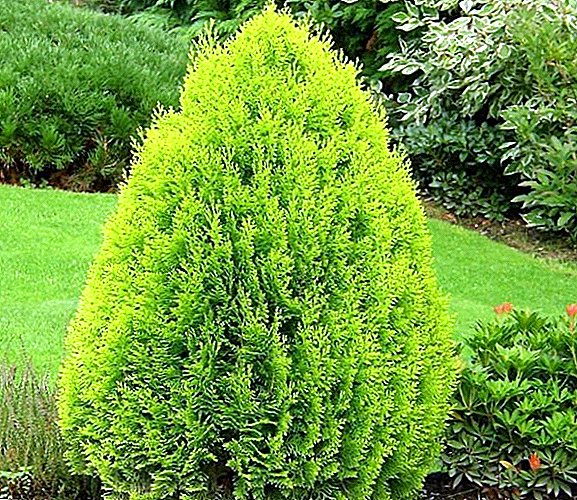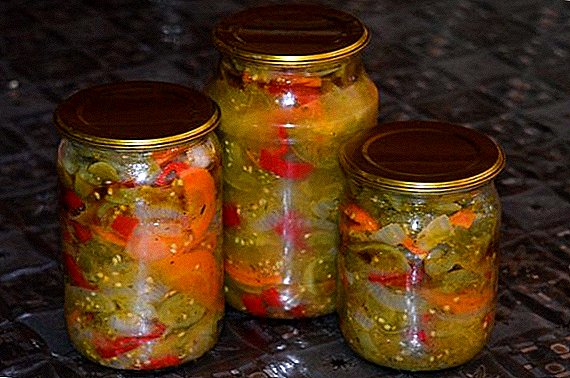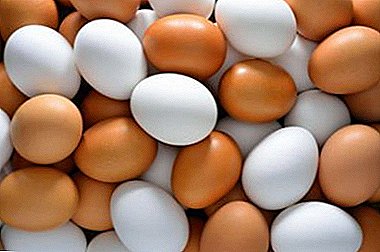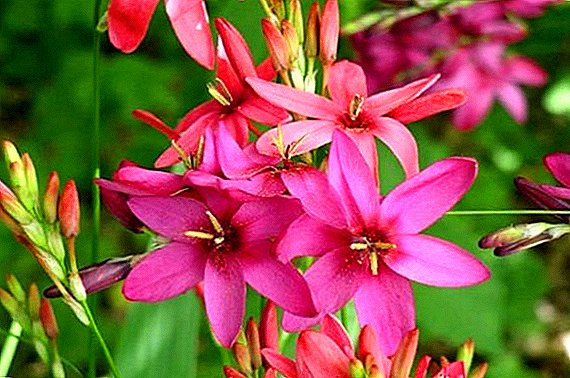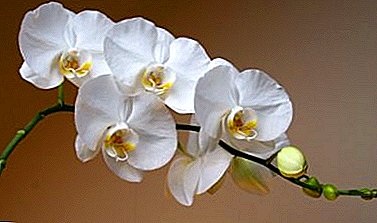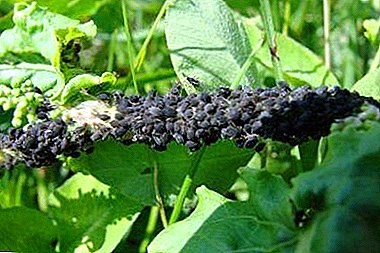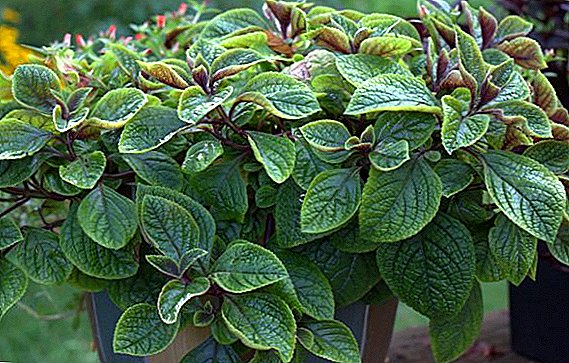 Mint room or house (other names - Swedish ivy, plechranthus, sporotsvetnik) - undemanding in the care of the culture with decorative foliage of various colors, filling the space with its beautiful and original look. The article will tell about the beneficial and harmful properties of mint, as well as how to plant, care for and where to apply the described culture.
Mint room or house (other names - Swedish ivy, plechranthus, sporotsvetnik) - undemanding in the care of the culture with decorative foliage of various colors, filling the space with its beautiful and original look. The article will tell about the beneficial and harmful properties of mint, as well as how to plant, care for and where to apply the described culture.
Plant description
Plektranthus is a fast-growing evergreen mint originally from the South African countries, widely distributed throughout the subtropical belt. Flowers of home mint look small purple-bluish or white spike-shaped inflorescences and do not have a special aesthetic appearance. Exceptionally thanks to foliage, this culture is considered decorative and deciduous.
The mint room has four-edged shoots hanging from a hanging pot and baskets hanging in a cascade of thick glossy foliage with carved edges. Leaves with a thick edge, in different species differ in patterns of veins and different shades, as well as a border. Fragrant leaves: if you hold your finger over the surface, in the room will spread a strong fresh fragrance. This culture is a medicinal plant that has wide application.
Did you know? In ancient Israel, people were taxed in the form of tithing from the cultivation and marketing of herbs, among which was mint.
The genus of plectrantus numbers more than 250 species, often not at all alike.
Here are some of them:
- Fragrant. The variety is very sprawling, with many branches, grows to a height of more than 2 m. The trunk of the plant is covered with small villi. Tetrahedral branches of an emerald or lilac shade. The large foliage is oval, in the upper part of the plant is blunt, and at the base is heart-shaped. Flowers exude a pleasant, delicate fragrance.

- Coleus. The plant has direct shoots. This subspecies has the largest leaves (more than 8 cm), having a beige or snow-white edging, sometimes with spotting and stripes. The plant has a pleasant, delicate aroma.

- Blum. This hybrid decorative culture reaches a height of over 80 cm. The shoots are mostly grassy, and the root is coarse. The foliage is rounded, on both sides with a velvety texture, pointed and elongated at the top, and along the edges with teeth. The shade of the foliage is bright emerald, but other colors and patterns can occur.

- Pleckrantus Ertendal. Herbaceous perennial, having creeping stems in length up to 45 cm. It is used as an ampelous culture. Leaf petioles opposite (up to 6 cm in length), dark green, ovate or rounded. The surface of the leaves is covered with a silver pattern of curls. The reverse side of the sheets has a reddish short nap. Blossoms pale lilac or white brushes (up to 35 cm), consisting of bells.

- Mona Lavender. This hybrid is an upright shrub. The brown-brown stems of the flower are covered with large ovate leaves of deep green color, with a jagged edge. The leaf plates are glossy on top, and their underside is trimmed with purple villi. In early autumn, the hybrid appears long lush inflorescences, studded with large purple-blue with blue specks tubular flowers.

- Dubolistny These plants have powerful upright trunks dotted with leathery leaflets with a serrate edge, like those of oak foliage, and the smell of needles (if you rub a leaf with your fingers, they will have a persistent pine aroma). The foliage is dark green, covered with short silvery fibers.

Useful and harmful properties
Consider the positive and negative effects of Swedish ivy on the organisms of people of different ages and conditions.
Beneficial features:
- From young shoots (tops with buds) they brew medicinal teas and are used as an effective diuretic, anti-inflammatory, expectorant, and also as a sedative for the nervous system.
- Some insects are afraid of the intense smell of room mint (thanks to this there is another popular name for the plant - the molar tree). You can make small canvas bags, where to pour the dry leaves of the plant and put in places where clothes are stored - this will help scare away the mole. Mint leaves can also be used to repel mosquitoes (if there are no allergic reactions in the history, you can rub the skin with fresh mint juice).
- Indoor swedish ivy, located on a windowsill or elsewhere, will drive away flies.
- Natural essential oils of the described culture have a positive effect on the cure of enuresis, rashes of various origins, depression and even bad mood. To do this, add its sheets while taking aromatic baths.
- It is recommended to place the plant near the workplace (for example, on the table in the office). When a person stays near a flower for a long time, essential oils from the leaves will eliminate runny nose, heavy breathing, pressure jumps and asthma, filling the surrounding air with phytoncides.
- Western pharmacology makes plectrantus medications, suturing wounds, as well as healing agents for the walls of the stomach and intestines affected by the ulcer.
Did you know? The liquid alcohol industry uses menthol extracted from mint in the production of high-quality cognacs.
Some contraindications and harm:
- Obstetricians and gynecologists do not recommend the use of mint preparations for pregnant and lactating women.
- It is forbidden to use decoctions from the plant to children under 12 years of age.
- For persons with hypersensitivity of the skin, it is not recommended to keep the plant in itself, since its essential oils and phytoncides can cause various forms of dermatitis.
- It is not recommended to eat homemade mint for people with low blood pressure and varicose veins.
- It is unacceptable to overeating dishes using plants, as well as the abuse of ready-made preparations based on room mint with increased acidity of the stomach.
How to choose the best variety of homemade mint
As experienced gardeners advise, choosing mint varieties for cultivation at home, you need to decide on its use: in cooking, for the manufacture of medicinal products or for soap making at home. After all, each type of this culture differs in the chemical composition of the essential oil and in the strength of its aroma.

Here are some differences in the use of different varieties of mint:
- spearmint is used in cooking for cooking first courses, as well as meat and fish;
- Apple (due to the gentle aroma, as well as the absence of bitter taste) is used as an additive when cooking jams, compotes and jelly;
- field is part of the tonic cocktails and drinks;
- with the addition of dlinnolistnoy mint at home make soap, as well as other cosmetics.
Conditions for content
Indoor Pleckranth needs the following conditions:
- bright, diffused daylight without direct sunlight (especially in summer) is required;
- in winter, a pot with a mint plant is put on a well-lit window sill on the south side or additional lighting is used with fitolamps (due to insufficient light input, the culture will develop poorly and motley foliage will lose its color);
- since the Swedish ivy is moisture-loving, the ground should always be moderately wet, without an excess of water: if you allow the soil to dry out, the buds and leaves will begin to fall off, and the overflow will lead to the rotting of the roots;
- for home mint, temperature conditions in the range of + 18 ... + 25 ° С (in summer) and + 15 ... + 17 ° С - in winter will be suitable;
- an increased air humidity is required (up to 70%), which can be arranged by arranging pots with flowers in water tanks;
- at the end of spring, the culture must be taken out to a well-lit loggia or garden;
- culture should be protected from drafts and temperature extremes.
Important! Do not spray the foliage of the plectrantus with water, because after this procedure there are spots on the leaves, because of which the plant may lose its decorative appearance.
Care and cultivation at home
To grow house mint with preservation of its decorative effect, a number of rules are necessary for its care.
Soil and the choice of capacity for landing
When planting room mint to begin with are determined with the choice of soil mixture and capacity.
To do this, follow the following principles:
- The soil mixture in its composition should contain a sufficient amount of peat. For this, ready-made fertile substrates from a specialized store are best suited.
- In addition to nutritional value, the earth should contain acidity at pH 6.
- A suitable earth mixture will also be a substrate of humus, sheet and sod soil and sand (1: 1: 1: 1).
- It is permissible to prepare the soil by yourself, choosing fertile garden or garden substrates that need to be disinfected with potassium permanganate solution, and then additionally shed the soil with boiling water (to destroy soil bacteria that can harm the indoor plant).
- For planting take a wide and high pot, because the culture is formed of a highly branched root system. Vases can be made of ceramic, plastic or glass, always with drainage holes.
- A good potted drainage layer is imperative.

Watering and fertilizer
Plectrantus is watered with soft and slightly warm water after the topsoil has dried. In the hot period, it will be useful to humidify the air in a room with a flower by spraying moisture around the crop (without falling on the foliage), and during the cold period of the year, watering is somewhat reduced.
Indoor culture needs regular feeding during the whole growing season. To do this, use complex fertilizers for decorative foliage crops with a frequency of 1 time per month, alternating between mineral fertilizers and organic. Before budding, mint is fed with fertilizers recommended by ornamental flowering crops, especially for abundantly flowering species and hybrids.
Trimming and transplanting
Periodic pruning of shoots, or rejuvenation of plants (when the stems are exposed in the lower part) are also included in the care of room mint. Usually, the stems that stretch after the winter are pruned (they should be shortened by half the length). Young shoots pinch for greater pomp of the bush (this will stimulate the growth of new twigs). Weakened shoots need to be cut constantly. Cut stalks can be used for breeding.
Important! It is not recommended to place a pot of homemade mint near heaters and in an overly stuffy room.
Peppermint has its own characteristics:
- young bushes are transplanted every year in spring;
- adult plants once in 2 years.
Reproduction room mint
Swedish ivy is grown in two ways:
- from seeds purchased in the store or collected personally;
- cuttings.
Seed propagation:
- Suitable for sowing seeds calcined soil mixture in the oven and allow to cool.
- Cover the substrate in a wide and shallow container and moisten it.
- Make furrows at a distance of 5 cm from each other and a depth of 5 mm and evenly distribute the seed material. Carefully seal the grooves.
- The container with the seedlings is placed on the windowsill on the bright warm veranda and is covered with a film on top.
Method of propagation by cuttings:
- In the spring and summer, they cut the apical cuttings and put them in a container with a solution of "Kornevina" or are immediately planted in a wet substrate.
- For seedlings need to organize abundant watering.
- Cover each seedling with a mini greenhouse made of plastic bottles.
- Seedlings need periodic airing.
- Decorative seedlings are ready for independent life in 10-12 days.
Video: Reproduction of plectranthus cuttings
Collection methods
Collect leaves from mint bushes according to certain rules that must be followed in order not to harm the plant:
- harvesting plectrantus, plucking leaves from it in different places, while respecting the symmetry of the bush;
- near the stalks leave 0.5 cm of the leaf sinus.
Accurate harvesting helps to form a decorative-looking plant and stimulates its further growth. On the ground collected leaflets will soon appear new.
Read also the useful tea with mint.
Application methods
Consider whether it is possible to use an aromatic plant with health benefits in the preparation of various dishes, as well as in folk healing.
Some ways to use peppermint in cooking:
- in Indonesian cuisine, the plant is a part of soft drinks, tea, canned food, and also it is used in dishes of national cuisine (soups, meat and fish dishes);
- mint serves as decoration of dishes;
- leaves are ground in a blender and added to various cocktails and drinks;
- Swedish ivy is good as a seasoning for various types of meat and as a part of sauces.

Homemade mint is used in traditional medicine for the following disorders:
- the aromatic plant cures disorders of the nervous system and sleep (tinctures, decoctions and soothing teas are used);
- headache (vegetable compress of leaves and decoction);
- insect bites (compress from crumpled leaves);
- inflammation of the throat and gums (gargle);
- weeping diathesis (leafing);
- bedsores and diaper rash (powdered with dry crushed leaves with the addition of pharmaceutical powder);
- in the complex treatment of enuresis;
- asthma, cough and nasal congestion (rinsing);
- flatulence;
- in the form of a natural sleeping pill.
We advise you to read how to freeze the mint for the winter at home.
Possible cultivation difficulties
There is a high resistance of plectrantus to harmful insects and diseases. But with inadequate care and maintenance of the plant in an inappropriate environment, infection with parasites or fungal diseases is possible, after which it may wither and even die.
Possible diseases of culture and ways to eliminate them:
| Problems / Diseases | The reasons | Elimination |
| Root decay |
|
|
| Wilted condition |
|
|
| Foliage shrunk and changed color |
|
|
| Mealy dew |
|
|
| Perinosporosis (downy mildew) |
|
|
Possible harmful insects, methods of their identification and elimination:
| Pests | Signs of defeat | Way to get rid |
| Aphid |
|
|
| Mealybug |
| |
| Spider mite |
|
|
As can be seen from the article, house mint is an unpretentious plant with many virtues. And if you decide to start this flower with fragrant leaves in your apartment, then a good emotional atmosphere in the house, air filled with volatile production, as well as a fragrant food supplement and a natural doctor in one "bottle" are guaranteed.











